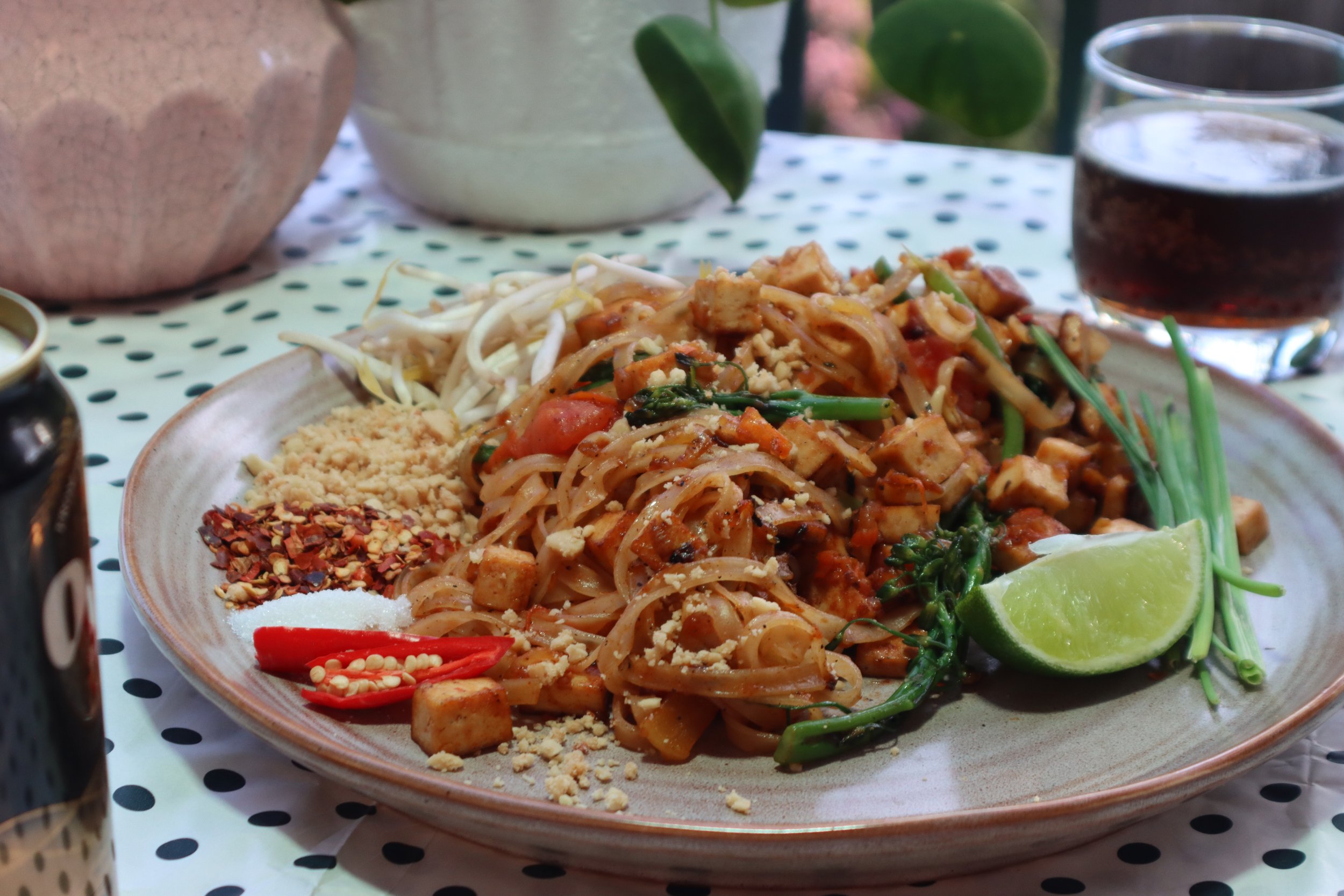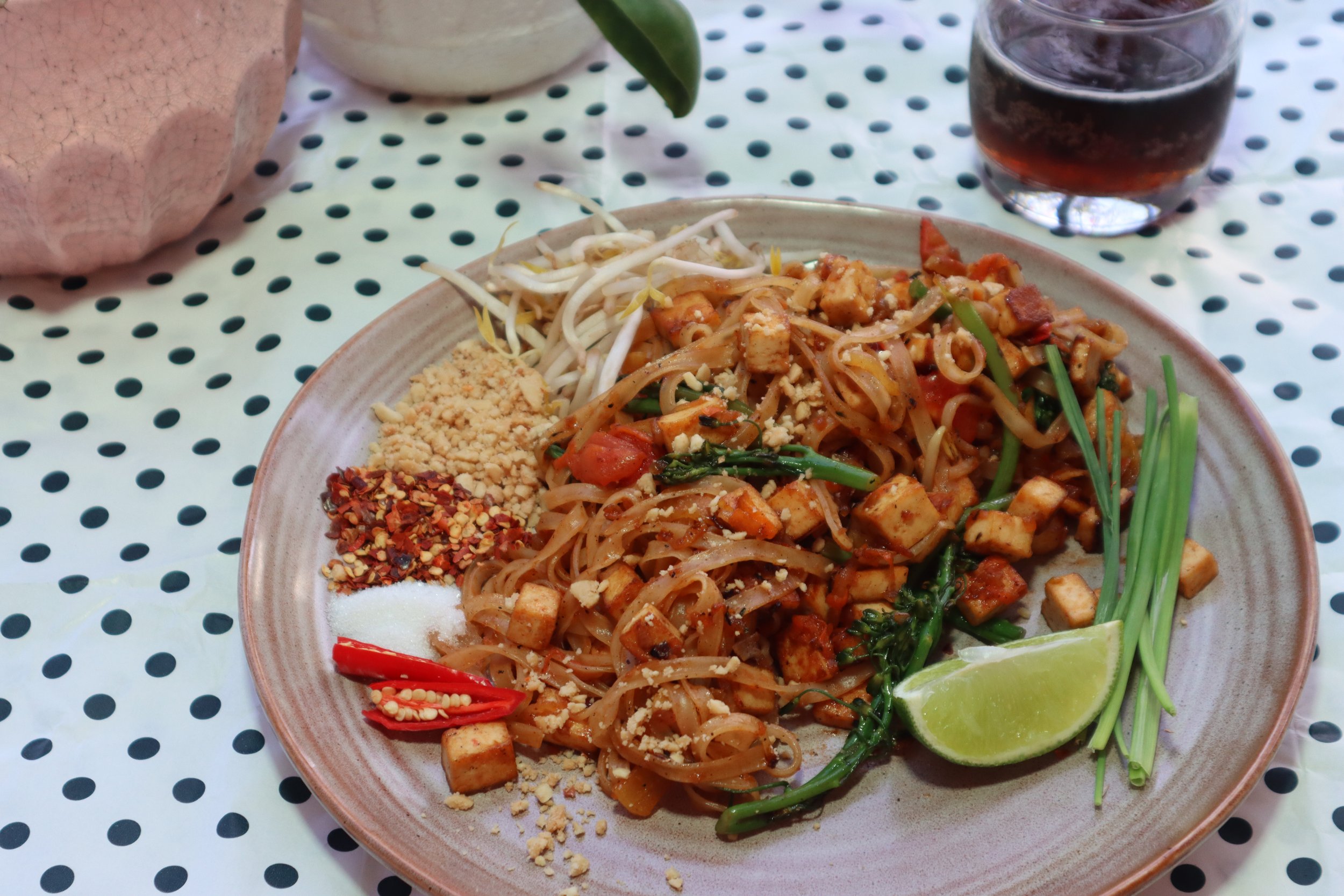VEGAN PAD THAI
INSPIRED BY AN INTENSIVE RESEARCH MISSION
IN BANGKOK TO DISCOVER THE VERY BEST
PLANT BASED PAD THAI
In early 2023, I spent one month in Bangkok,
specifically the duration that the Thai government allows you to stay before they boot you out - studying the art of vegan pad Thai. I ordered dozens. I had fish inspired ones, I had the simple vegetable focused pad Thai still served at the restaurant that claims (amongst others!) that they were the first to ever serve it. I went to street vendors, fancy restaurants and food courts alike and everywhere I went.. I put a plant based pad Thai in the mix. For research. For the animals. I did this for all of us.
I also went to two cooking classes that specifically heroed this dish to compare their techniques, and all along the way noted the trends and flavours to bring you this: my best crack at recreating the ultimate vegan pad thai like they do in Thailand. So what are the key learnings?
Pad Thai isn’t actually as old as you might think.
This iconic national dish of Thailand is less than 100 years old! Brought to life in the 1930’s in an effort to celebrate Thai ingredients, the Thai government promoted this new dish to encourage the use of rice noodles in a time when rice shortages were prevalent. It’s not taken long for it to become a worldwide phenomenon and signature national flavour.
Vegan Pad Thai is possible to find in Thailand!
Thailand has a massive buddhist population, so animal product free cuisine is commonplace across the country. Looking out for red and yellow ‘jae’ (เจ) signs will lead you to vegan-friendly food made without chilli, onion or garlic. These signs are all over the place, and the whole country celebrates a jae festival every october where this animal-product free cooking is celebrated all over Thailand. Because of this, versions of pad thai made without fish sauce and egg aren’t hard to find. Check out my incoming vegan guide to Bangkok for more details on how knowing how to hunt for jae food will make your time in Thailand much easier as a vegan.
The sauce doesn’t need to be very complex.
The flavour sauce on pad thai uses tamarind, palm sugar and fish sauce to achieve the signature flavour profile. Vegan fish sauce can be found at most asian supermarkets these days, and if you can find it then definitely make my sauce recipe for big, sexy Thai flavour profile. Chef’s Choice is a vegan-owned brand from Thailand that produces a vegan fish sauce as well as pre-made pad thai sauce that’s ready to stir through.
But for those who aren’t purists, May Kaidee (Thai veg legend) has a cooking school (in Bangkok, Chiang Mai and New York) where she recommends making a sauce with half dark and half light soy sauce to use on pad thai. As someone who made this version directly under her tutelage, I can confirm it makes a glorious pad thai anyway, all without the extra ingredient sourcing effort.
Egg helps stop the noodles from sticking to the wok, but there’s ways around it.
Egg is in the traditional version for flavour and texture, but it also is introduced halfway through cooking at a point that helps stop the rice stick noodles from sticking to the wok without extra oil being added. Never fear, fellow vegans! Being more generous with your tofu portion (accounted for in my ratios) helps compensate for the bulk the egg adds to the dish. If you want that hit of eggy flavour, a very light dusting of kala namak (indian black salt) over the dish right before serving will do the job.
For cooking though? It’s even simpler. Keep a glass of water near the wok before cooking (you should anyway, hydration is key!). When the rice stick noodles hit the wok, a small splash of water and vigorous mixing should be more than enough to keep them from sticking. If needed, an extra splash of water will continue to buy you time as the dish cooks, but if you’re moving quickly - the sauce is added pretty soon after to make everything slippery, delicious, and not attached to the bottom of your wok when it comes to serving.
Plating up the dish is where the magic truly happens!
If you take a peek of the video on this page compiling some of the vegan pad thai I found, you’ll see no two look the same! Sometimes the garnishes are tossed over the top, sometimes they’re barely able to be found, but my absolute favourite way is to serve them (peanuts, white sugar, salt, lime wedges, chives & additional bean sprouts) is in little piles around the plate.
Not only is it adorable, it means you can pump out pad thai portions and let people adjust to their own palate. Mixing it all through and diving in works for me, but it also means everyone can bring these flavours in to every bite to their exact preference. I also loved that some places served fresh banana blossom heart on the side of a pad thai, so if you’ve followed my fresh banana blossom harvesting guide - this recipe right here is a lovely place to use your heart.
DO I NEED STRANGE INGREDIENTS?: If you’re new to thai cooking, tamarind puree and palm sugar might not be in your pantry.. but they shouldn’t be hard to find at a local supermarket. This recipe is so delicious, you’ll surely use them regularly if you invest in some of each, but if you don’t want to add more ingredients to your clutter - easy alternatives are provided within the recipe.
I also recommend you look out for preserved radish (a yellow pickled daikon found refrigerated in asian supermarkets - check out my how-to video for a visual reference). It adds a delightful flavour very characteristic of a classic pad thai, but it’s absolutely not mandatory so just add an extra handful of veggies if you can’t find it.
VARIATIONS?: Changing or leaving out the vegetables recommended are acceptable variations. If you have access to a lovely, pan-fryable egg substitute (like justegg), then scrambling some of this to stir through would be suitable. However, this product isn’t available where I live so I’ve not tested this nor do I think it’s necessary.
Portions here given are for a hearty single serving for my greedy pad thai-loving self, but you could likely serve 2 normal humans with self restraint using the below recipe portions. I’ve made the serving size adjustable in the recipe card so you can adapt it to your greeds and needs.

Vegan Pad Thai
Ingredients
- 90g rice stick noodles
- 2 tablespoons chopped pickled radish (it’s yellow and refrigerated at asian supermarkets)
- 150g tofu (pressed and in small cubes)
- ½ cup fresh bean sprouts
- 2 tablespoons chopped shallots
- 4 stalks of fresh chives or spring onion
- 1 tablespoon cooking oil
- ⅓ - ½ cup vegetables (my fave choices are carrot - grated, broccoli - in small pieces, tomato - in small pieces)
- 1 teaspoon white sugar
- 2 teaspoons chilli flakes
- 1 tablespoon crushed peanuts
- A lime wedge
- 2 tablespoons grated palm sugar
- 2 tablespoons tamarind purée
- 2 tablespoons vegan fish sauce (or half/half dark and light soy sauce)
- 1 teaspoon chilli paste
Instructions
- Soak the noodles in room temperature water for 30-45 minutes while you prep your ingredients. Whisk together the sauce ingredients to make a smooth paste.
- Make sure everything is chopped and set up close to the wok, plus keep a cup of water handy nearby. Heat the oil in a wok over high heat, then add the shallots a minute. Toss in the tofu until the tofu begins to brown, for approximately 2 more minutes whilst keeping the wok contents moving frequently. Add the radish and extra vegetables for 2 minutes, stirring constantly to avoid sticking. Add the bean sprouts, then the soaked noodles and a few tablespoons of water for 2 minutes.
- This is the part of the recipe where an egg would normally help stop the noodles from sticking to the wok, so be vigilant to see if extra splashes of water are needed through-out this step. Keep on stirring and mixing! Pour in most of the sauce then cook for another minute until the noodles are thoroughly mixed and coated in sauce. Have a test and see if the remaining sauce is needed, then switch off the heat.
- Serve the other half of the bean sprouts on the side, along with little piles of the sugar, peanut and chilli. These are to be mixed in as you eat so that every bite is to your exact liking. Plate the noodles into the centre and rest the lime wedge, some extra peanut and the chives on top - serve hot!
Nutrition Facts
Calories
878.42Fat
27.07 gSat. Fat
2.91 gCarbs
139.02 gFiber
9.91 gNet carbs
129.14 gSugar
39.49 gProtein
25.53 gSodium
3146.28 mgCholesterol
0 mg

